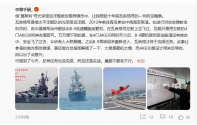View attachment 88180
Here's more details about the 2012 incident during the joint exercise with AK-630. The drone involved was a
and the Russian ship taking a shot was Varyag of the Russian Pacific Fleet, another Slava class. She opened fire with four AK-630 and didn't score any hits on the first pass. Afterwards the Russians explained that their AK-630 was designed to defend against missiles and not against such a slow target.
That explanation is what makes me a bit nervous about any PLAN ships armed with AK-630 or derived CIWS.
I’m pretty sure the problem is with the fire control rather than the Ak630 literally not being able to shoot straight.
The PLAN would have done their own extensive tests on their ships with AK630s, and if those guns were garbage, they would have stripped them out long ago never mind build their own version.
I think the main inherent ‘issue’ with the AK630 would be the mounting, but that’s more a design choice rather than a defect I think.
The AK630 has a small mount, and if you see videos of them firing, the visible shaking is quite considerable. As already mentioned, that is a design choice rather a defect because the AK630 is designed to throw rounds in a wide cone to achieve maximum hit probability. Think of it as a shotgun.
Chinese 730 and 1130 OTOH has significantly bigger bases and are much more stable when firing. Again, that’s a very deliberate design choice to have a much tighter spread of rounds.
The wide spread of the AK630 is to compensate for the limitations of fire control systems when it was designed; and also because that approach was sufficient against NATO subsonic AShMs.
The 730/1130 were designed when far superior fire controls are available, and also when far more dangerous missiles are being faced in the form of Russia export supersonic AShMs; Taiwan’s domestic supersonic HFs and potentially also with an eye on the horizon and looking at hypersonics.
The design choices can also be seen in the choice of ammo.
The AK is designed to damage an incoming subsonic and make it miss or crash into the sea. The 730/1130 are instead designed to shred incoming missiles to ribbons.
As with all things, there are costs and trade offs. The 730/1130s require much more sophisticated fire controls systems; take up a much bigger footprint on ships, and are much more expensive to buy and shoot. That makes it fundamentally not suitable for many applications that the AK can fulfil, for example, just mounting it will probably sink an 022; and the costs probably aren’t justified for support ships etc; So there are uses for both systems within a navy.

